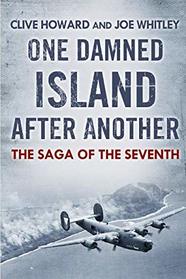Although the book has a few problems, it is a fascinating story of an air force that---quite frankly---I didn't even know existed.
The 7th Air Force was originally called the Hawaiian Air Force. It was the first to feel the fury of the Japanese attack on Pearl Harbor. But it sprang back to help lead the way across the Central Pacific and even fought in the Southwestern Pacific theater.
Part of the problem, which the two authors complain about early on, was that the Central Pacific offensive was controlled by the Navy, which made sure it got most of the credit. So 7th Air Force units were seldom mentioned in press releases.
If you are knowledgeable about the American strategy of by-passing Japanese-held islands and just neutralizing them by frequent air strikes, but always thought that was a Southwest Pacific policy, then think again. Most of that kind of action went on in the Central Pacific and the 7th Air Force was heavily engaged in that mission.
The two authors were soldier-correspondents in the 7th. Early on they relate why they are going to tell the tales of the common soldier, rather than just the heroes. And they do a very good job of this.
The major problem the book has is the authors reported the success of the 7th missions as reported by the pilots when they returned from those missions. Such reports are not often closely accurate, for example, the Japanese happily reported the U.S.S. Enterprise sunk several times. [Makes you wonder what the Japanese civilians thought : "Oh, we sunk the Enterprise again. That makes the third time, doesn't it?"] In this book, the authors report B-17s from the 7th Air Force obtained 22 hits on Japanese surface vessels at the Battle of Midway. Post-war research proved the B-17s obtained no hits at all. So, when the authors report fantastic results from air strikes, you might want to be a bit skeptical.
Finally, while not overly frequent, the authors apparently didn't have the book proofread and there are more than a few typographical errors in the book.
The 7th Air Force was originally called the Hawaiian Air Force. It was the first to feel the fury of the Japanese attack on Pearl Harbor. But it sprang back to help lead the way across the Central Pacific and even fought in the Southwestern Pacific theater.
Part of the problem, which the two authors complain about early on, was that the Central Pacific offensive was controlled by the Navy, which made sure it got most of the credit. So 7th Air Force units were seldom mentioned in press releases.
If you are knowledgeable about the American strategy of by-passing Japanese-held islands and just neutralizing them by frequent air strikes, but always thought that was a Southwest Pacific policy, then think again. Most of that kind of action went on in the Central Pacific and the 7th Air Force was heavily engaged in that mission.
The two authors were soldier-correspondents in the 7th. Early on they relate why they are going to tell the tales of the common soldier, rather than just the heroes. And they do a very good job of this.
The major problem the book has is the authors reported the success of the 7th missions as reported by the pilots when they returned from those missions. Such reports are not often closely accurate, for example, the Japanese happily reported the U.S.S. Enterprise sunk several times. [Makes you wonder what the Japanese civilians thought : "Oh, we sunk the Enterprise again. That makes the third time, doesn't it?"] In this book, the authors report B-17s from the 7th Air Force obtained 22 hits on Japanese surface vessels at the Battle of Midway. Post-war research proved the B-17s obtained no hits at all. So, when the authors report fantastic results from air strikes, you might want to be a bit skeptical.
Finally, while not overly frequent, the authors apparently didn't have the book proofread and there are more than a few typographical errors in the book.




